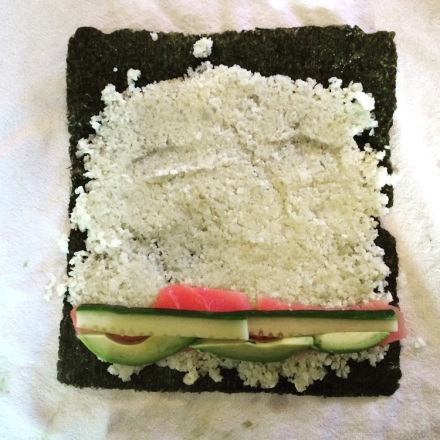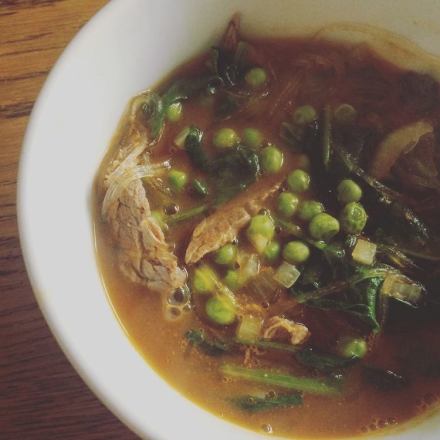I love how the food we make is never created in a vacuum. Even the recipes I create on my own are influenced by others—the way people I love cook or the way food I love (made by others) tastes. It’s this gorgeous give-and-take of flavor and color and technique. In this particular case, technique takes the stage. The art of rolling sushi was passed along to me by a dear friend, who learned from her sister-in law . . . and so the story goes.
These rolls are a paleo take on the traditional Kappa Maki Roll. I use fresh Ahi Tuna, cucumber, avocado, and cauliflower rice in place of traditional Basmati rice. The blend of flavors and textures compliment one another so well, you’ll be surprised it’s not the real thing.
So, grab a friend and make this one together—create a food tradition that’s worth sharing, because aren’t they all?
Cheers!
PALEO SUSHI ROLLS

1 head of cauliflower
1 package of seaweed wraps
1 fresh Ahi Tuna steak
1 cucumber
1 firm avocado
3 tablespoons (or more as needed) Olive or Avocado oil
1 tablespoon Sesame oil
1/2 teaspoon salt (+ additional to taste)
Coconut Aminios
Begin by making your cauliflower rice.
Chop a head of cauliflower into bite-sized pieces, and then in a food processor, pulse into rice-sized bits. I have a 7-cup processor and it takes several batches to get the whole head of cauliflower processed. This is the messy part of the recipe. But take your time—the more even-sized the bits of cauliflower are, the better they will roll!

In a large wok or deep skillet, heat olive (or avocado) oil on med heat. You’re not going to fry the cauliflower, you’re going to cook it, so make sure your pan isn’t too hot or it will splatter and burn. (Believe me, I learned this the hard way!) Add the cauliflower to the oil, sprinkle in salt, and mix thoroughly with a spatula. Feel free to taste and adjust salt as desired. Continue stirring occasionally until the rice begins to soften a bit and stick together. It will not be as sticky as actual rice, but it will clump a bit when moved around the pan. You don’t want it too soft or mushy (like a paste) so be careful not to overcook.
Once cooked through, remove the pan from heat and set aside.

Now it’s time to slice and dice!
Using as sharp a knife as you can find (and being very careful of your digits!) thinly slice your Ahi Tuna, avocado, and cucumber* into strips. Aim for no thicker than a #2 pencil and as long, or longer than, your finger.
*When slicing the cucumber, cut length-wise into quarters and slice out the seeds until only the meat remains. You can leave the skin on, or cut if off, whatever you prefer.
Once the main ingredients are all sliced, set them within easy reach. It’s time to start rolling. This is the part that I always found super intimidating, but it’s way easier than it seemed initially, and you don’t HAVE to have all the traditional rolling tools. I use a soft spatula and a cotton dish towel. Easy peasy.
Spread a dishtowel on a clean work surface and lay a single sheet of seaweed wrap on top of it. Using your spatula, scoop a heaping spoonful of cauliflower rice onto the sheet and spread it gently over the whole surface of the wrap (except for about a 1/2 inch at the very top). It will not stick as well as rice so you won’t have to work it quite as much. Think of it like spreading frosting.
Mmmmmm. Frosting.
Again, leave about half an inch of space at the top of the wrap. —When you finish the roll, this will act like an envelop flap, sealing all the ingredients inside.

At the very bottom of the wrap, lay out the tuna, avocado, and cucumber lengthwise and on top of one another, edge to edge. These will form the center of the roll, so the tighter everything is, the smoother and more compact the roll will be. Snug them up tight. Remember rolling up your younger siblings in a blanket across the living-room floor? Same principal. (Someone please tell me I wasn’t the only one who did this. . .)
Taking the bottom edge of the seaweed wrap, lift it gently and begin rolling, tucking it up and around the ingredients. Roll as tightly as you can without splitting the wrap. This is where the dishtowel comes in handy. Once the roll is started, you can use the dishtowel as a sort of covering to press and smooth the roll, keeping it tight and even without splitting the wrap. This part takes a little practice. The first several rolls I made were pretty ugly, but once you’ve got the technique down, it goes quickly.
When you reach the top of the roll, scrape any excess rice that may have spilled over, off the top of the wrap’s “envelope lip,” and dabbing your finger in water, swipe it along the top of the wrap the same way you would lick the seal on an envelope. Finish the roll over top the lip to seal, and then stand back and look at your work. Even it out, keeping the seal on the bottom-side of the roll, and then whip out your sharpest knife, again being careful of your fingers, and slice away! The two end pieces will be the messiest, and if you choose, go ahead and nosh on them while you work. You need nourishment after all!
Slice the rolls about 1 inch thick and set aside.
Continue the process until you have used up all the rice. You should be able to make seven or eight rolls with one head of cauliflower rice.

Serve with a small dipping bowl of sesame oil and coconut amino.
Enjoy!
 In a saucepan heat 2 cups of chicken stock to boiling. Add a dash of salt. Turn burner off.
In a saucepan heat 2 cups of chicken stock to boiling. Add a dash of salt. Turn burner off.






